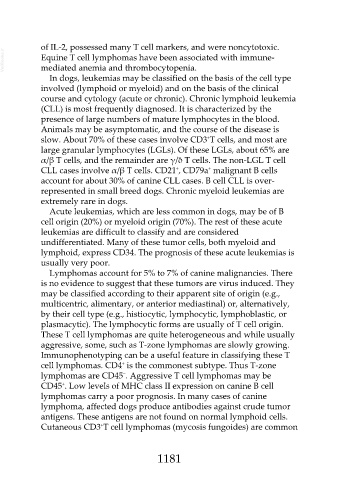Page 1181 - Veterinary Immunology, 10th Edition
P. 1181
of IL-2, possessed many T cell markers, and were noncytotoxic.
VetBooks.ir Equine T cell lymphomas have been associated with immune-
mediated anemia and thrombocytopenia.
In dogs, leukemias may be classified on the basis of the cell type
involved (lymphoid or myeloid) and on the basis of the clinical
course and cytology (acute or chronic). Chronic lymphoid leukemia
(CLL) is most frequently diagnosed. It is characterized by the
presence of large numbers of mature lymphocytes in the blood.
Animals may be asymptomatic, and the course of the disease is
+
slow. About 70% of these cases involve CD3 T cells, and most are
large granular lymphocytes (LGLs). Of these LGLs, about 65% are
α/β T cells, and the remainder are γ/δ T cells. The non-LGL T cell
+
+
CLL cases involve α/β T cells. CD21 , CD79a malignant B cells
account for about 30% of canine CLL cases. B cell CLL is over-
represented in small breed dogs. Chronic myeloid leukemias are
extremely rare in dogs.
Acute leukemias, which are less common in dogs, may be of B
cell origin (20%) or myeloid origin (70%). The rest of these acute
leukemias are difficult to classify and are considered
undifferentiated. Many of these tumor cells, both myeloid and
lymphoid, express CD34. The prognosis of these acute leukemias is
usually very poor.
Lymphomas account for 5% to 7% of canine malignancies. There
is no evidence to suggest that these tumors are virus induced. They
may be classified according to their apparent site of origin (e.g.,
multicentric, alimentary, or anterior mediastinal) or, alternatively,
by their cell type (e.g., histiocytic, lymphocytic, lymphoblastic, or
plasmacytic). The lymphocytic forms are usually of T cell origin.
These T cell lymphomas are quite heterogeneous and while usually
aggressive, some, such as T-zone lymphomas are slowly growing.
Immunophenotyping can be a useful feature in classifying these T
+
cell lymphomas. CD4 is the commonest subtype. Thus T-zone
−
lymphomas are CD45 . Aggressive T cell lymphomas may be
+
CD45 . Low levels of MHC class II expression on canine B cell
lymphomas carry a poor prognosis. In many cases of canine
lymphoma, affected dogs produce antibodies against crude tumor
antigens. These antigens are not found on normal lymphoid cells.
Cutaneous CD3 T cell lymphomas (mycosis fungoides) are common
+
1181

